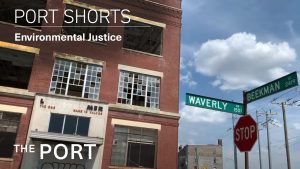Port Short: Economic Equity Part II
In part one of our series examining economic equity and inclusion in Hamilton County, we learned there is a plan in place to advance the merits of economic equity and inclusion in the construction supply chain.
We learned that a critical component of The Port’s long-standing economic inclusion strategy is to provide match-making opportunities for majority-owned firms with minority-owned, women-owned and small business enterprises.
And we learned that in order to significantly move the needle of economic equity and inclusion leaders must be intentional about their efforts.
In part two of this series, we’ll take a look at whether this ‘intentionality’ is turning into ‘reality.’
Joe Jackson, CEO and owner of Battle Axe Construction, acknowledges progress has been made in sharing the profits, but also believes we can be better.
“I've been in business for 17 years, and I feel like here within the last three to five years, the city has made more progress than previous. I feel like we're on the right path. I just feel like more needs to be done. We need more involvement from others to surpass the barriers that is currently in place.” - Joseph Jackson, CEO & Owner, Battle Axe Construction
So, it’s clear in-roads have been paved for economic equity and inclusion success. But, if more is still needed, how do we create trail breaking results?
“And one of the things that’s rally key for us is there’s a term called ‘BHAG.’ And really what BHAG is is a bold, hairy audacious goal. So it’s a bold goal that really changes the trajectory of what you’re working on. And really, if you look at it, why couldn’t it be that our supply base reflects our communities? So why don’t we look like a mirror?” - George Simms, Interim President & CEO, Ohio Minority Supplier Development Council
Let’s get back to ‘intentionality.’
One general contractor says it is very intentional when bidding out projects.
Nic and Suzy Manning own Manning Contracting, a woman-owned and small business enterprise. The Mannings say if we want to drive an equitable and inclusive share of the wealth in the construction supply chain, the effort can’t just be mailed in:
“We call it intentionality, we call it thinking outside the box, also, it’s just like, some of it’s just effort. If you just put out a blast email and throw your hands up and say ‘hey, it’s our best effort’ we just couldn’t get anybody to respond. You could do that, I guess, I mean that was the reality, but for us it was like ‘ok, how do we think more critically here to get more folks involved?’” - Nic Manning, General Manager, Manning Contracting
“Until we get to the point that this isn’t a conversation that is highlighted but just part of the normal course of business, I think having those positions that The Port has, having those economic equity and inclusion positions that are actually really looking at how we can make this work I think is important instead of just saying ‘well everyone has a little part in it’ but how do you actually make it so that it’s at the forefront of the work being done?” - Suzy Manning, President, Manning Contracting
Economic equity and inclusion is not a passing popular trend. It’s not a nice to have, it’s a need to have, and smart business leaders recognize our economic growth is at stake. Some say, it’s mission critical.
“When we talk about EE&I, we talk about it from a social perspective, which is important, but there’s a business opportunity. And one of the key things is if you look at Ohio, Ohio is number seven in the list of top ten states as far as GDP. Unfortunately, Ohio has the lowest growth rate in the top 10, and if you look at the power of EE&I it has the ability to go in and lift our GDP by 5% a year over the next five years. So really, it is a business imperative.” - George Simms, Interim President & CEO, Ohio Minority Supplier Development Council
Another way to spread the economic wealth, industry leaders say, is to share what hasn’t worked, and perhaps more importantly, what has:
“I believe The Port should share their blueprint with other organizations within the city. If multiple organizations within the city of Cincinnati adapt The Port's strategy, there would be spontaneous change. There would be a lot of dollars flowing into minority businesses, women owned businesses. There'd be ample opportunities for more businesses.” - Joseph Jackson, CEO & Owner, Battle Axe Construction
The calling cards of economic equity and inclusion are evident all around the region, with many more hands still to be dealt.
Not buying in? Hamilton County leadership wants business leaders to know.. it’s watching:
“What I’m looking for is that when I look at the statistics and the data I can see some evidence that things have changed. That we can see a change and people don’t see it as something that’s threatening to them.” - Commissioner Stephanie Summerow Dumas, President, Hamilton County Board of Commissioners
Check out our other Port Shorts:
Port Shorts: Kao USA, Inc. and Powell Valves
The Port’s unique toolkit and expertise in managing complex real estate projects has helped many companies and municipalities throughout Cincinnati and Hamilton County. This area of The Port’s work takes place primarily behind the scenes, but its impact in the form of investment and jobs is felt throughout the region. A recent public-private collaboration involving two Cincinnati companies with a long history in Camp Washington is a […]
(Video) Port Shorts: Historic Structure Stabilization Program
Hamilton County is home to hundreds of historic, vacant structures, but many are in serious disrepair. Buildings such as the Mt. Healthy Theater, the historic home at 4661 Hamilton in Northside, the mixed-use structure on 722 East McMillan in Walnut Hills, and Italianate structures in the West End like 1916 Freeman are all a vital […]
(Video) Port Shorts: Environmental Justice
Cincinnati’s strong manufacturing heritage helped build the Queen City we know today. Manufacturing in Cincinnati hit its peak in 1969, but today you can still see signs of this industrial prowess throughout the city and county. Many of these sites provide the backdrop for our city’s architectural character and robust engineering workforce, but other parts […]
(Video) Port Shorts: The Homesteading & Urban Redevelopment Corporation (HURC)
Housing affordability is a national challenge, and far from a simple one to address. In Cincinnati and Hamilton County, the need for affordable housing stock is enormous. Nearly 49,000 households in Hamilton County are severely cost burdened, paying more than 50% of their income toward housing costs. The Port and its managed entities, the Hamilton […]



